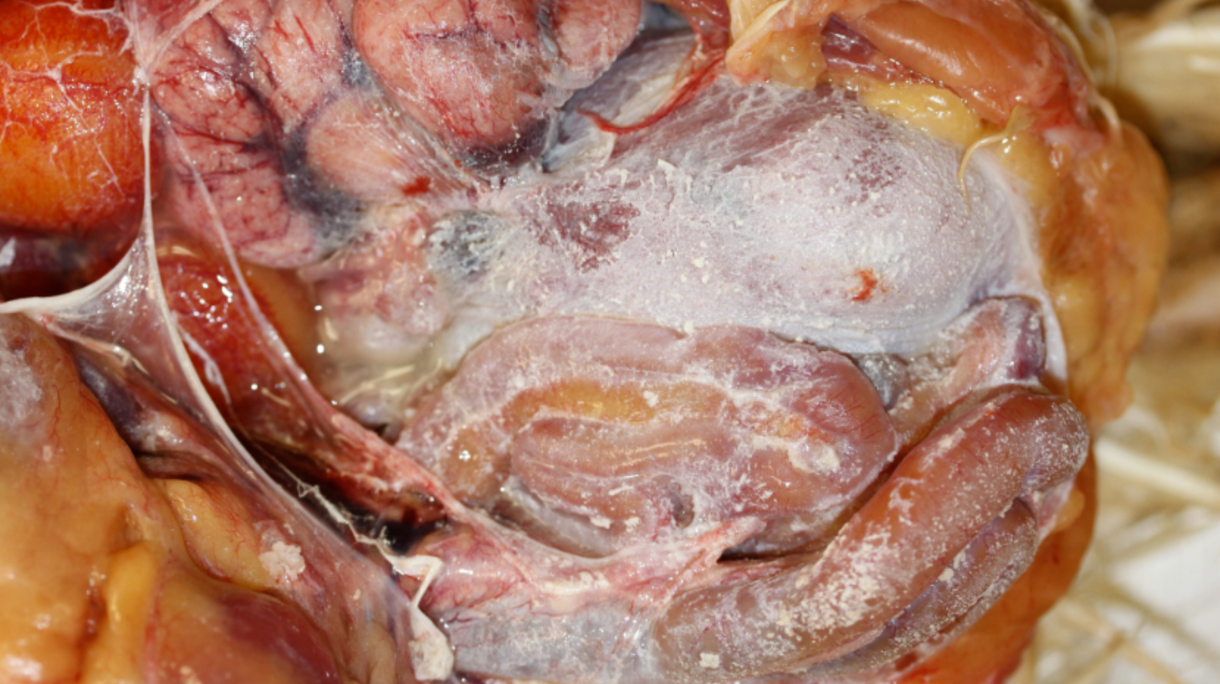
Published on Dec. 14, 2023
Visceral Gout
Visceral gout, a metabolic disorder in birds, arises due to excessive uric acid accumulation in the body, especially when renal function is impaired. Birds typically excrete urates in their urine, but impaired renal clearance leads to hyperuricemia, resulting most commonly in uric acid deposits on the surface of visceral organs or other extra-visceral sites (visceral gout) and more rarely within joints (articular gout).
Acute urate deposition, a counterpart to uremia in mammals, occurs in rapidly progressing renal failure and leads to deposits on the pericardium, peritoneum, and liver capsule. This condition may be secondary to urolithiasis, often caused by factors like infectious bronchitis virus or dehydration. Chronic urate deposition, similar to gout in mammals, manifests after long-term increases in serum uric acid levels, forming deposits on synovial membranes in joints.
Articular urate deposition, causing chronic granulomatous reactions to urate crystals, is less common but results in joint enlargement and deformities.
Both forms of gout underline the importance of renal health, with various factors such infectious agents, dietary imbalances and exposure to toxins contributing to their development:
- Feeding rearing pullets with a diet containing excess of calcium (especially before 14 weeks of age) will result in kidney damage.
- Vitamin A deficiency
- Dehydration: frequently seen in ready to lay pullets after transfer if they do not adapt to drinkers in the production house
- Infectious Bronchitis virus: some strains are nephropatogenic and can produce permanent damage to the kidneys
- Toxins: many different substances can alter the kidney function: mycotoxins (ochratoxin, DON…), some antibiotics (sulfas), heavy metals and pesticides are known to be nephrotoxic.
Clinical signs
Symptoms of visceral gout are not specific, and generally include decreased feed and water intake, lethargy, ruffled feathers, weight loss, lameness and dirty vents. Articular gout affected birds may exhibit lameness, and swelling of the feet and/or joints causing discomfort and impaired movement. Polyuria (excessive urination) and polydipsia (increased thirst) are also notable symptoms, highlighting the metabolic imbalance and renal dysfunction associated with the condition.
Postmortem examinations reveal emaciated carcasses with urate deposits on various organs including the pericardium, liver, kidneys, ureters, and air sacs. Kidney lobules are usually enlarged (compensatory enlargement) to maintain renal function. Uric acid deposits can also be found in joints.
Diagnosis
Diagnosis of visceral gout is made based on postmortem findings: chalky white deposits of urate crystals on the serosal surface of pericardium, liver, intestines, air sacs, kidneys and ureters. Microscopically kidneys reveal ureter crystal deposition with degenerative changes in tubular epithelium.
Treatment and control
Managing visceral gout in poultry involves a complex approach focusing on nutrition, prevention, and treatment strategies. Prevention primarily revolves around careful dietary management, including limiting calcium level to 1% in powder form for pullets up to 16 weeks and maintaining appropriate phosphorus levels to prevent kidney damage. Pre-lay rations with 2.50 % calcium should not be introduced too early.
Ensuring proper vitamin levels, especially A, D3, K, and B complex vitamins and a suitable electrolyte dietary balance (avoiding alkaline diets with too high levels of Na and K) is also crucial in prevention.
Raw materials used in poultry diets should be of good quality and adding toxin binders when needed will limit the impact of mycotoxins.
Additionally, a proper vaccination program against infectious bronchitis (IB) adapted to local conditions and field challenge is essential for preventing eventual kidney damage.
Proper management at transfer is also key and an effort should be made to encourage water intake at transfer to avoid dehydration. Increasing light intensity for a few days for easier adaptation to new drinkers and avoiding too dark spots in the house (paying attention to lower tier in battery cages) are important points to monitor.
Acidifying the urine through compounds like ammonium chloride, ammonium sulfate, DL-methionine, or methionine hydroxy analogue can help dissolve kidney stones and preserve renal function in affected birds.
References
- Alice Mitchell. (2016). Alice Mitchell. The Poultry Site. https://www.thepoultrysite.com/articles/avianurolithiasis-
visceral-gout-an-overview
- Poultry DVM. (n.d.). Gout . Poultry DVM . Retrieved October 5, 2023, from https://poultrydvm.com/
condition/gout
- Rocio Crespo. (2023). Urate Deposition (Gout) in Poultry. Merk Manual Veterinary Manual. https://www.
merckvetmanual.com/poultry/miscellaneous-conditions-of-poultry/urate-deposition-gout-in-poultry
- Sandhyarani, K., Madhuri, D., & Ravikumar, Y. (2021). Review - Gout In Chicken. Advances in Animal and
Veterinary Sciences, 10(3). https://doi.org/10.17582/journal.aavs/2022/10.3.702.711

